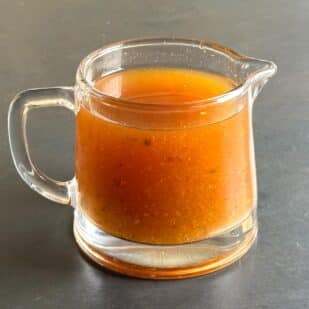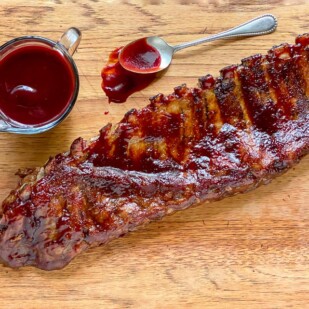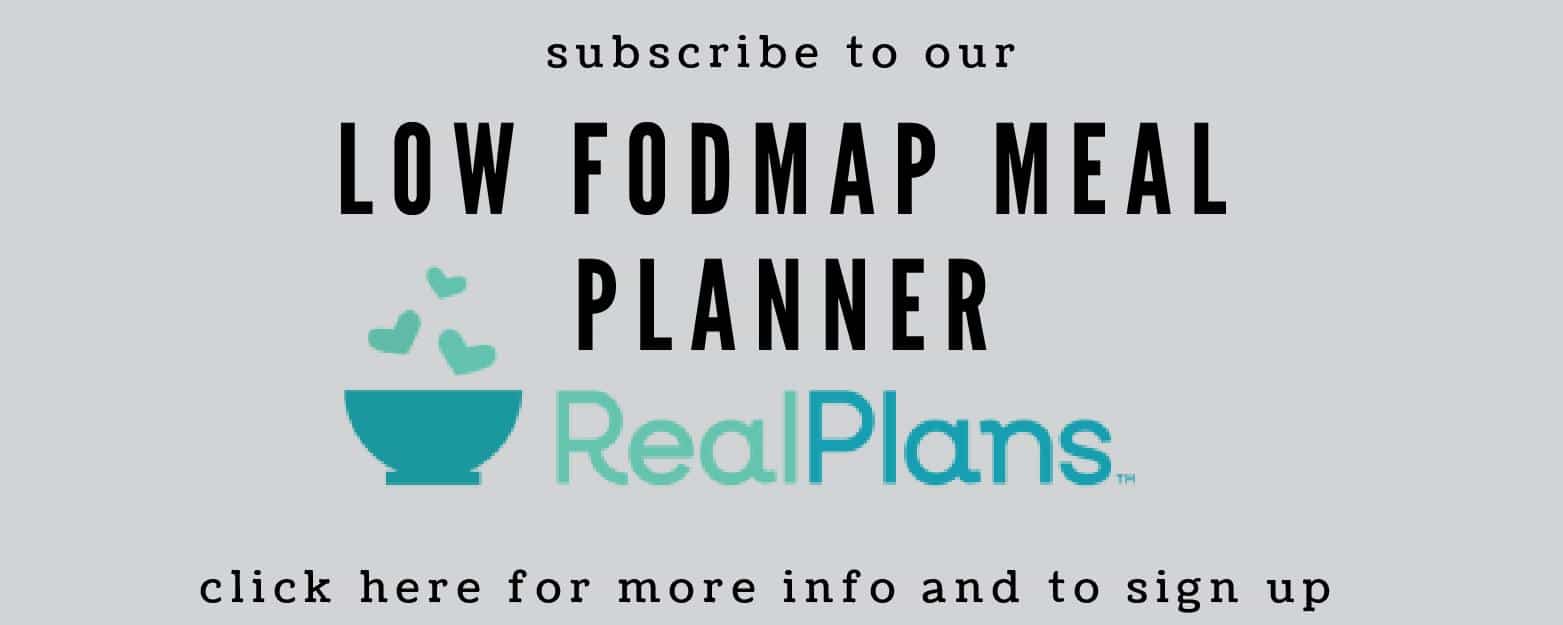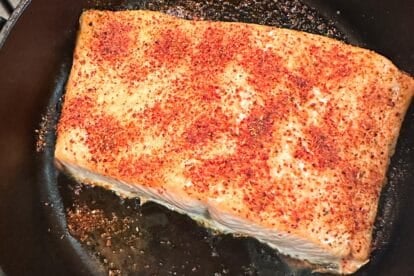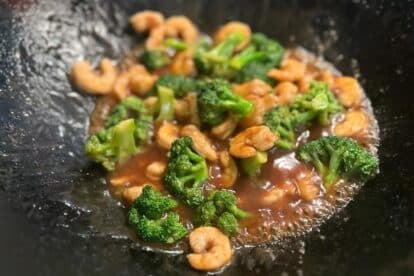These Asian-inspired Low FODMAP Five-Spice Ribs with Plum Sauce have a flavorful dry rub in addition to a glossy, sweet and tangy plum-based sauce. Plums, you ask? Black diamond plums have been lab tested for FODMAPs and have a small low FODMAP serving size of 2 g.
We know that sounds like a small amount – and it is – but thankfully we know what FODMAPs are in plums – sorbitol, which is a Polyol – so if we know our tolerance to that FODMAP, we can adjust the serving size of this recipe. Please note the “P” icon at the top of the recipe. It denotes that this recipe contains Polyols. This recipe is for those who have finished their Challenge Phase and understand their relationship to sorbitol, in particular.
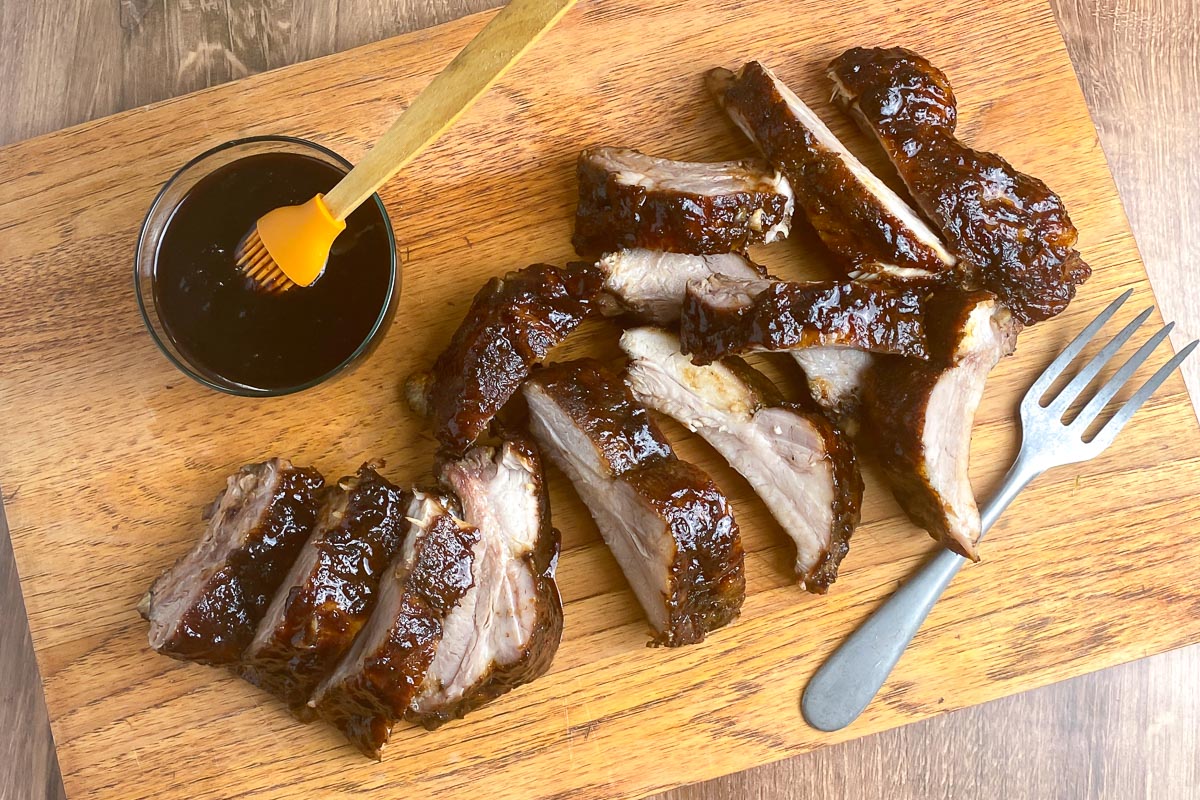
Also note that we like to allow the dry rub to permeate the meat for 4 hours before cooking, so plan accordingly. You can also do that step the day before.
Buying Baby Back Ribs
When you go to the supermarket, or are looking at the butcher’s refrigerated case, you might encounter a few different kinds of ribs. For this recipe we are talking about baby back ribs in particular. We like baby back ribs because of their potentially tender texture, flavor and ratio of bone to meat.
Kinds of Pork Ribs
There are ribs that might be labeled as baby back ribs, spareribs, or St. Louis-style ribs. Then to make it more confusing, baby back ribs, which are what you want for this recipe, might also be labeled as loin ribs, back ribs, or even loin back ribs! If there is a meat counter person to chat with, by all means do so, so that you will know you are getting the right thing. Buy the baby back ribs.
Remove The Silverskin
Another reason to engage with a butcher is to ask them to remove the silverskin (sometimes spelled sliver skin). This is a thin silvery membrane of connective tissue on the underside of your rack of ribs. Here is a video that shows you how to remove it yourself, if you want to give it a go.
Removing the silverskin allows the dry rub to penetrate the meat more evenly and the finished texture of the cooked ribs will be more tender.
BTW racks of baby back ribs can have 10 to 13 ribs, so number of ribs per serving size will vary.
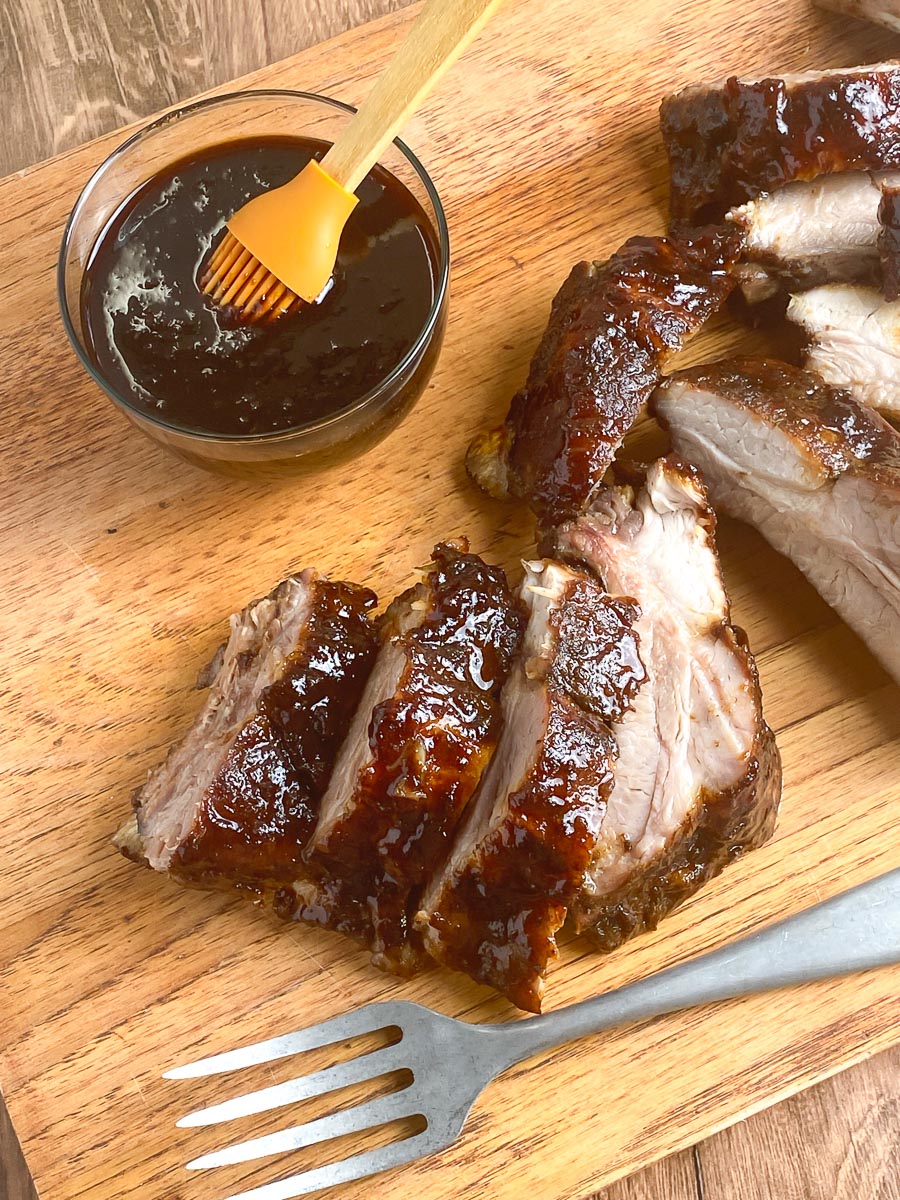
Frequently Asked Questions
Five-spice powder is a spice mixture of five or more spices used predominantly in Chinese cuisine and Taiwanese cooking. The 5 spices are typically star anise, cloves, cinnamon, fennel seeds, and Szechuan pepper. The five flavors of the spices – sweet, bitter, sour, salty, and savory – refer to the five traditional Chinese elements. Recipes do very though, and sometimes you will see anise seed, ginger, nutmeg, turmeric, cardamom, licorice, orange peel, and sometimes galangal.
Monash University has lab tested five spice powder and there is a low FODMAP serving size of 1 teaspoon or 2 g.
Sweet soy sauce, also known as ketjap manis or kecap manis, is a completely different condiment from that referred to simply as soy sauce. You cannot use soy sauce for this recipe. Sweet soy sauce is thicker and much sweeter, typically sweetened with palm sugar. It almost has the texture of molasses.
Monash University has lab tested Black Diamond plums. They have a small low FODMAP serving size of 5 g. We know this sounds terribly tiny, and it is. It ends up being about 1 ½ teaspoons. These Black Diamond plums contain sorbitol, which is a polyol. Do you know your tolerance to sorbitol?
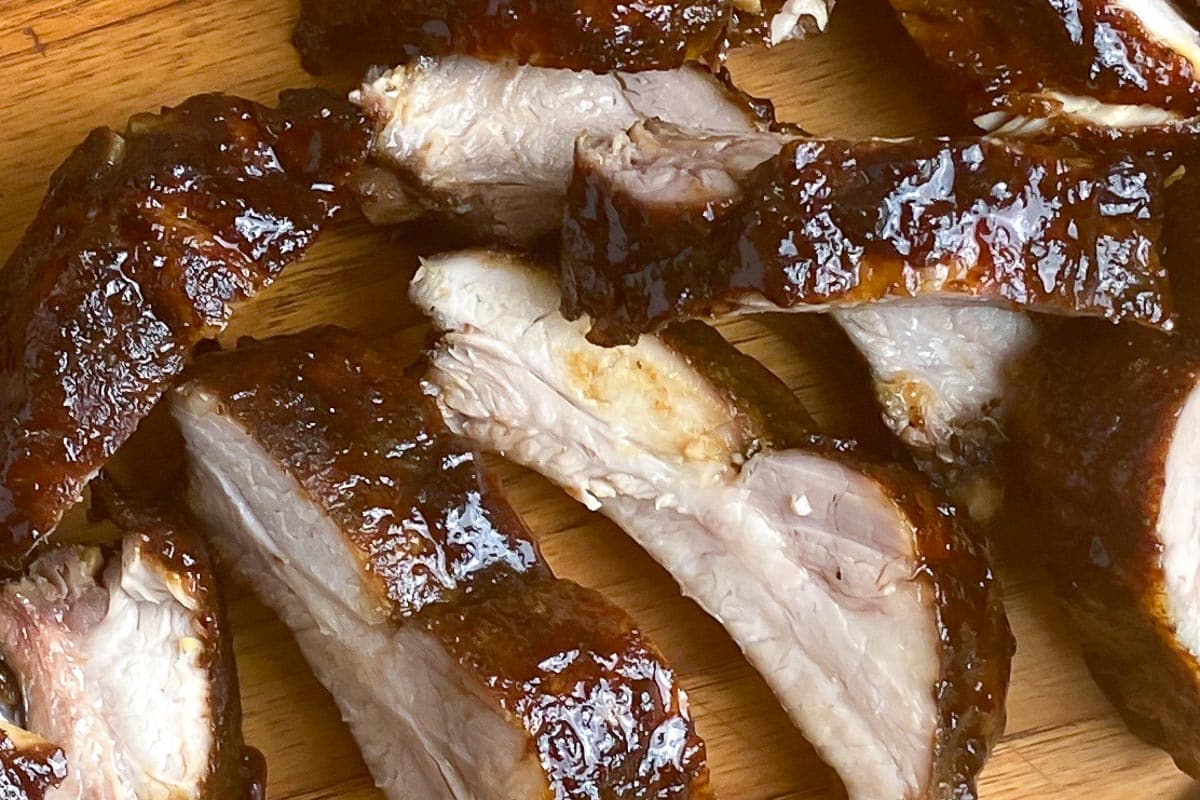
How To Make Low FODMAP Five-Spice Ribs with Plum Sauce
For the Dry Rub & Ribs: In a small bowl, stir together the brown sugar, five-spice, salt, FreeFod Garlic Replacer, paprika, pepper and ginger.
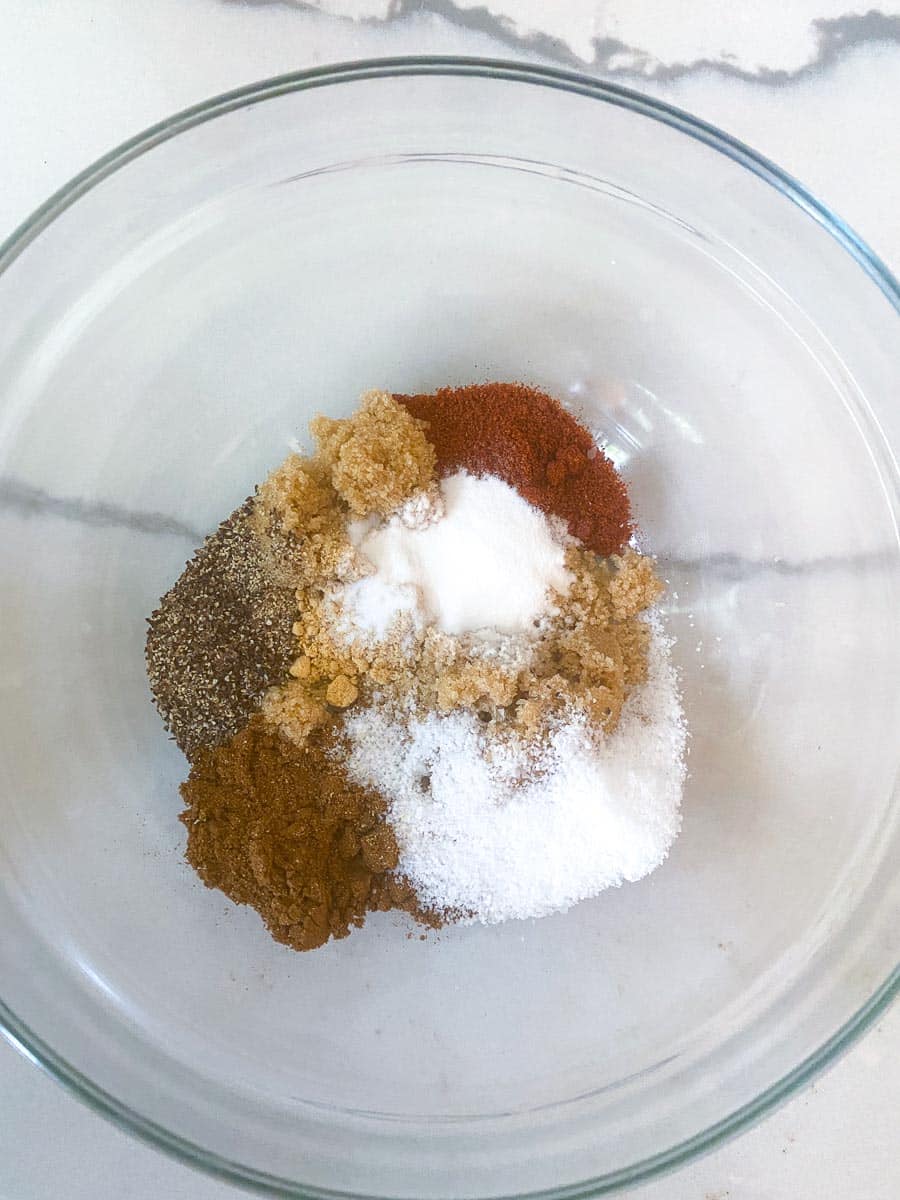
Rub every surface of the ribs – both sides, even the bones – with the dry spice mixture. Wrap in foil and refrigerate for at least four hours or overnight.
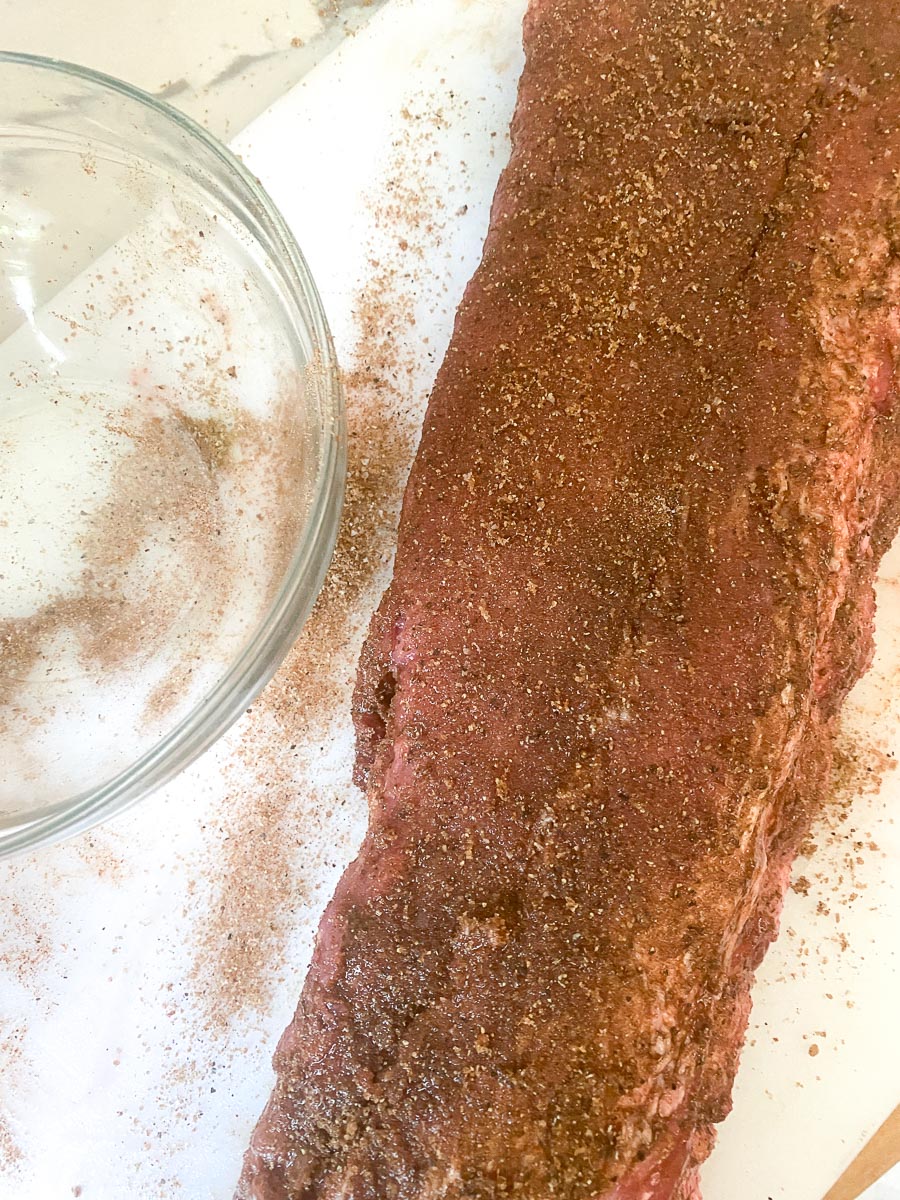
Make The Sauce: Meanwhile, place all of the sauce ingredients in a nonreactive saucepan. Store together and bring to a simmer over low – medium heat. Use a potato masher to mash the plums and break down the pieces of fruit. Simmer the sauce, similar occasionally, for about five minutes or until it is thick and glossy. There should be no chunks of fruit. The fruit should be broken down and incorporated into the shiny sauce.
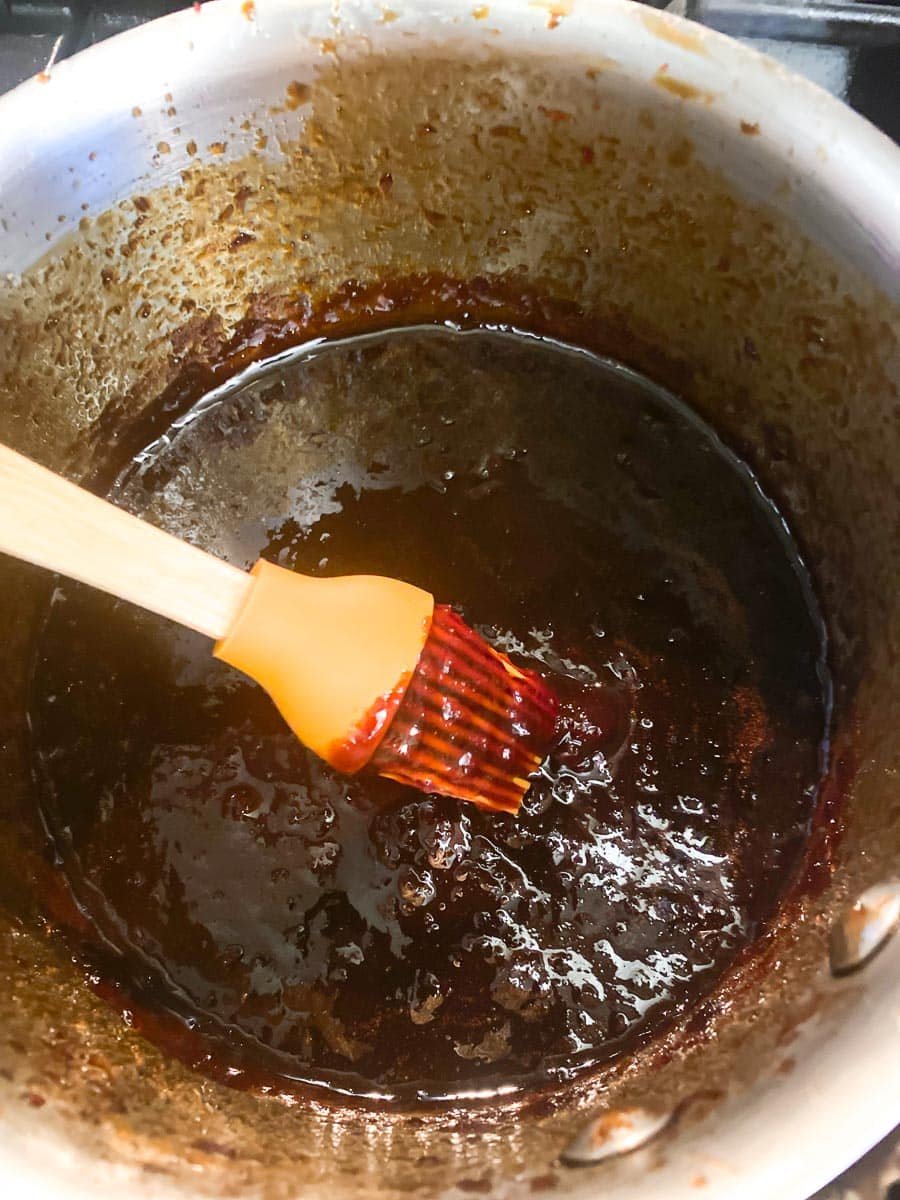
Cook The Ribs: Bring the ribs to room temperature. Position rack in middle of oven. Preheat oven to 250° F (121° C). Place foil wrapped ribs on a roasting pan.
Roast ribs for 2 ½ hours. Check at this time to assess tenderness. They should be very tender, and you may roast for a bit longer if desired. If you jiggle a bone, it should feel loose within the meat.
Unwrap ribs and discard foil and any accumulated juices. Place ribs directly on large roasting pan and coat with plum sauce on both sides, using about a heaping ½ cup (120 ml) of sauce total. Preheat broiler to high with rack about 4-inches (10 cm) below broiler. Broil ribs on both sides, about 2 to 5 minutes per side, or until charred here and there. Ribs are ready to serve.
FODMAP Information
All recipes are based upon Monash University & FODMAP Friendly science at time of initial publication.
- Brown Sugar: Brown sugar has been lab tested by both Monash University and FODMAP Friendly. There are many kinds of brown sugar, from cane to beet (to blends) to Muscovado and more, which we discuss in our Explore An Ingredient: Sugar. Unfortunately, there is no information about what kind of brown sugars were lab tested. Monash gives us a low FODMAP amount of ¼ cup or 40 g but no further information. In addition, in private correspondence with Monash University we know that there are amounts larger than 40 g that would be considered low FODMAP. FODMAP Friendly gives us a low FODMAP amount of 13 g. Dark brown Muscovado sugar does appear in a product lab tested and certified low FODMAP by FODMAP Friendly, so we do know there is a low FODMAP amount.
- Low FODMAP Garlic Powder: Conventional garlic powder is made from dried and granulated, or powdered, garlic cloves and is considered high FODMAP. There are a couple of low FODMAP garlic powders on the market: FreeFod Garlic Replacer and Fodmazing Garlic Substitute Replacer. The FreeFod has been lab tested and is certified low FODMAP by FODMAP Friendly. Both brands contain the same ingredients – maltodextrin and natural garlic flavor. We find them to be excellent additions to your herb and spice collection. Use them as you would conventional garlic powder.
- Vinegar: Several vinegars have been lab tested by both Monash and FODMAP Friendly. From Monash: Apple cider vinegar is low FODMAP at 2 Australian tablespoons or 42 g; Balsamic vinegar is low FODMAP at 1 Australian tablespoons or 21 g; Malt vinegar contains no FODMAPs; Rice wine vinegar is low FODMAP at 2 Australian tablespoons or 42 g. From FODMAP Friendly: Balsamic gets a “Pass” at 2.5 tablespoons or 42 ml. Apple cider vinegar gets a “Pass” at 1 tablespoon or 14 g (don’t ask me why one is in milliliters and the other in grams).
Please always refer to the Monash University & FODMAP Friendly smartphone apps for the most up-to-date lab tested information. Foods will be retested from time to time; in the case of raw ingredients, such as fruits and vegetables, results may vary. All lab tested results are valid and represent a snapshot in time. As always, your tolerance is what counts; please eat accordingly. The ultimate goal of the low FODMAP diet is to eat as broadly as possible, without triggering symptoms, for the healthiest microbiome.
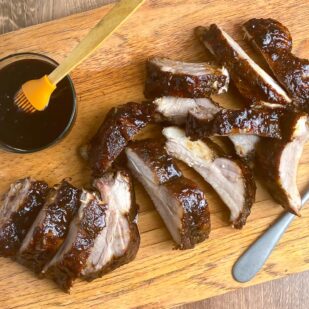
Low FODMAP Five-Spice Ribs with Plum Sauce
These Asian-inspired pork ribs have a flavorful dry rub in addition to a glossy, sweet and tangy plum-based sauce. Plums, you ask? Black diamond plums have been lab tested for FODMAPs and have a small low FODMAP serving size of 2 g. We know that sounds like a small amount – and it is – but thankfully we know what FODMAPs are in plums – sorbitol, which is a Polyol – so if we know our tolerance to that FODMAP, we can adjust the serving size of this recipe. Also note that we like to allow the dry rub to permeate the meat for 4 hours before cooking, so plan accordingly. You can also do that step the day before. Please note the “P” icon at the top of the recipe. It denotes that this recipe contains Polyols. This recipe is for those who have finished their Challenge Phase and understand their relationship to sorbitol, in particular.
Ingredients:
Dry Rub:
- 2 tablespoons firmly packed light brown sugar
- 2 teaspoons five-spice powder
- 2 teaspoons kosher salt
- 1 teaspoon low FODMAP garlic powder, such as FreeFod
- 1 teaspoon paprika
- 1 teaspoon freshly ground black pepper
- 1/2 teaspoon ground ginger powder
- 1 rack of baby back ribs, about 3-pounds/1.5 kg, silverskin removed (you can ask the butcher to do this)
Plum Sauce:
- 3, Black Diamond plums (5-ounces each), peeled and pitted, cut into chunks
- 2/3 cup (165 ml) sweet soy sauce
- ¼ cup (60 ml) rice vinegar
- ¼ teaspoon five-spice powder
- 1/8 teaspoon ground ginger powder
Preparation:
-
For the Dry Rub & Ribs: In a small bowl, stir together the brown sugar, five-spice, salt, FreeFod Garlic Replacer, paprika, pepper and ginger. Rub every surface of the ribs – both sides, even the bones – with the dry spice mixture. Wrap in foil and refrigerate for at least four hours or overnight.
-
Make The Sauce: Meanwhile, place all of the sauce ingredients in a nonreactive saucepan. Store together and bring to a simmer over low – medium heat. Use a potato masher to mash the plums and break down the pieces of fruit. Simmer the sauce, similar occasionally, for about five minutes or until it is thick and glossy. There should be no chunks of fruit. The fruit should be broken down and incorporated into the shiny sauce.
-
Cook The Ribs: Bring the ribs to room temperature. Position rack in middle of oven. Preheat oven to 250° F (121° C). Place foil wrapped ribs on a roasting pan.
-
Roast ribs for 2 ½ hours. Check at this time to assess tenderness. They should be very tender, and you may roast for a bit longer if desired. If you jiggle a bone, it should feel loose within the meat.
-
Unwrap ribs and discard foil and any accumulated juices. Place ribs directly on large roasting pan and coat with plum sauce on both sides, using about a heaping ½ cup (120 ml) of sauce total. Preheat broiler to high with rack about 4-inches (10 cm) below broiler. Broil ribs on both sides, about 2 to 5 minutes per side, or until charred here and there. Ribs are ready to serve.
Notes:
FODMAP Information
All recipes are based upon Monash University & FODMAP Friendly science at time of initial publication.
• Brown Sugar: Brown sugar has been lab tested by both Monash University and FODMAP Friendly. There are many kinds of brown sugar, from cane to beet (to blends) to Muscovado and more, which we discuss in our Explore An Ingredient: Sugar. Unfortunately, there is no information about what kind of brown sugars were lab tested. Monash gives us a low FODMAP amount of ¼ cup or 40 g but no further information. In addition, in private correspondence with Monash University we know that there are amounts larger than 40 g that would be considered low FODMAP. FODMAP Friendly gives us a low FODMAP amount of 13 g. Dark brown Muscovado sugar does appear in a product lab tested and certified low FODMAP by FODMAP Friendly, so we do know there is a low FODMAP amount.
• Low FODMAP Garlic Powder: Conventional garlic powder is made from dried and granulated, or powdered, garlic cloves and is considered high FODMAP. There are a couple of low FODMAP garlic powders on the market: FreeFod Garlic Replacer and Fodmazing Garlic Substitute Replacer. The FreeFod has been lab tested and is certified low FODMAP by FODMAP Friendly. Both brands contain the same ingredients – maltodextrin and natural garlic flavor. We find them to be excellent additions to your herb and spice collection. Use them as you would conventional garlic powder.
• Vinegar: Several vinegars have been lab tested by both Monash and FODMAP Friendly. From Monash: Apple cider vinegar is low FODMAP at 2 Australian tablespoons or 42 g; Balsamic vinegar is low FODMAP at 1 Australian tablespoons or 21 g; Malt vinegar contains no FODMAPs; Rice wine vinegar is low FODMAP at 2 Australian tablespoons or 42 g. From FODMAP Friendly: Balsamic gets a “Pass” at 2.5 tablespoons or 42 ml. Apple cider vinegar gets a “Pass” at 1 tablespoon or 14 g (don’t ask me why one is in milliliters and the other in grams).
Please always refer to the Monash University & FODMAP Friendly smartphone apps for the most up-to-date lab tested information. Foods will be retested from time to time; in the case of raw ingredients, such as fruits and vegetables, results may vary. All lab tested results are valid and represent a snapshot in time. As always, your tolerance is what counts; please eat accordingly. The ultimate goal of the low FODMAP diet is to eat as broadly as possible, without triggering symptoms, for the healthiest microbiome.
Nutrition
All nutritional information is based on third-party calculations and should be considered estimates. Actual nutritional content will vary with brands used, measuring methods, portion sizes and more. For a more detailed explanation, please read our article Understanding The Nutrition Panel Within Our Recipes.
